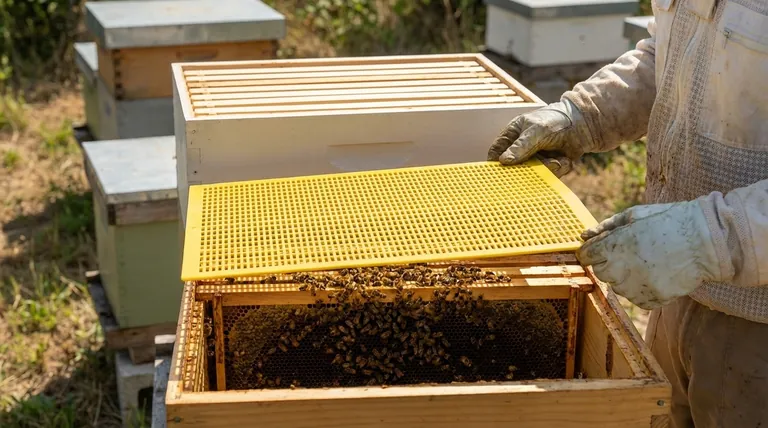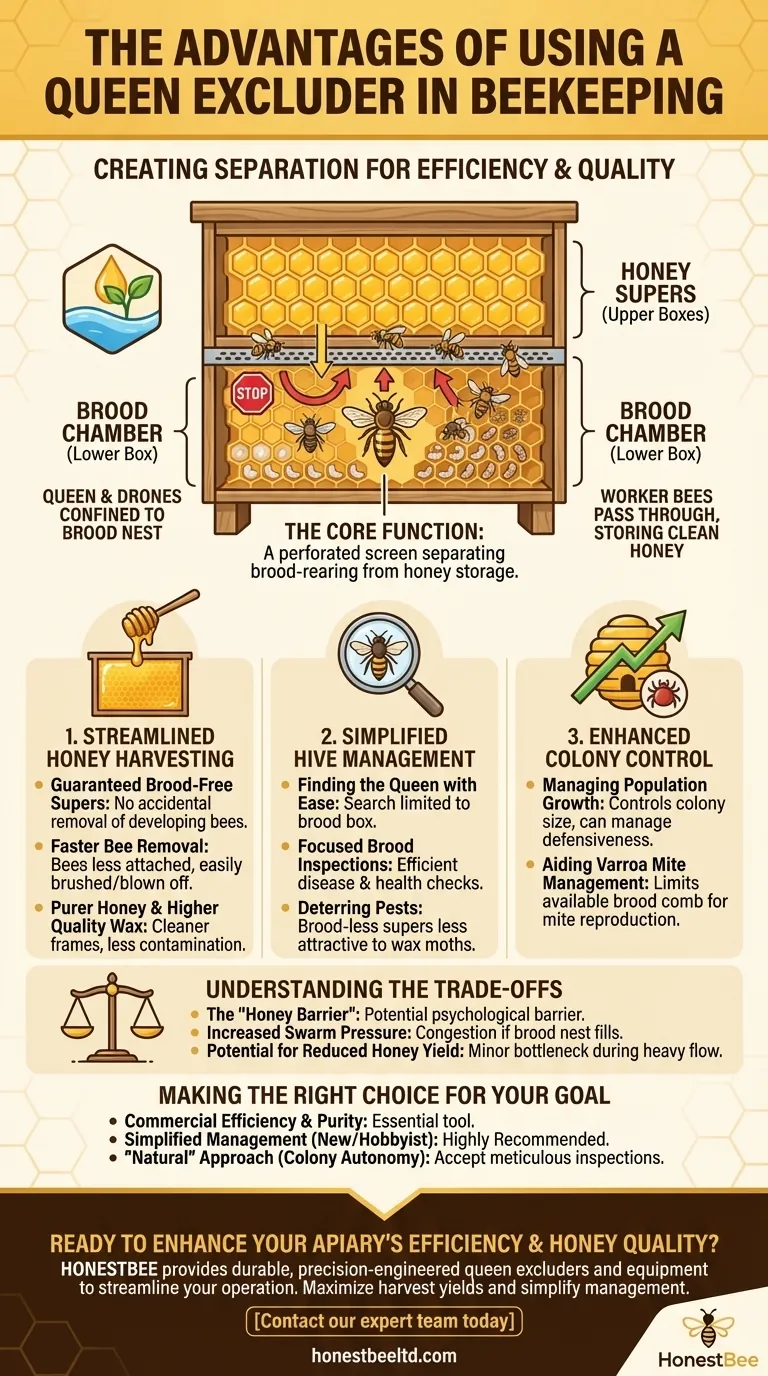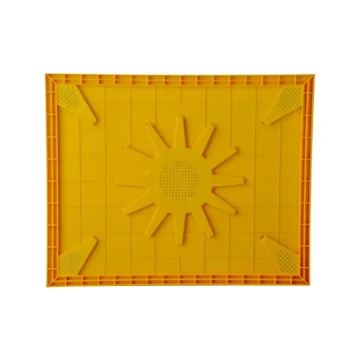The primary advantage of using a queen excluder is to create a clear separation between the queen's brood-rearing area and the hive's honey storage area. This single function simplifies hive management, streamlines honey harvesting, and results in a cleaner final product by ensuring honey supers are free of eggs, larvae, and pupae.
A queen excluder is a management tool that intentionally trades the hive's natural, unrestricted expansion for significant gains in beekeeper efficiency, colony control, and honey purity. It imposes order for a more predictable and streamlined process.

The Core Function: Creating Separation
A queen excluder is a perforated screen placed between the brood boxes and the honey supers. The openings are large enough for worker bees to pass through but too small for the larger queen and drones.
Confining the Queen to the Brood Nest
By physically barring the queen from the upper boxes (honey supers), you guarantee she can only lay eggs in the lower brood chamber.
This simple act of separation is the foundation for all of the excluder's subsequent advantages.
Advantage 1: Streamlined Honey Harvesting
For many beekeepers, especially commercial operators, the gains in efficiency during harvest are the most compelling reason to use an excluder.
Guaranteed Brood-Free Honey Supers
You can remove honey supers with absolute confidence that you will not find any brood. This eliminates the tedious, frame-by-frame inspection to ensure you aren't accidentally removing and killing developing bees.
Faster Bee Removal
During harvest, bees are more easily and quickly removed from honey supers. Since there is no brood to tend to in those boxes, the bees are less attached to them and can be brushed or blown off with greater speed.
Purer Honey and Higher Quality Wax
Frames that have never contained brood are cleaner. They have less pollen and "travel stain" contamination, resulting in purer honey and wax cappings that can be rendered into higher-quality beeswax.
Advantage 2: Simplified Hive Management
An excluder makes routine hive inspections and other management tasks significantly faster and less disruptive.
Finding the Queen with Ease
When you need to find the queen—for requeening, health checks, or mite counts—your search is limited to the one or two brood boxes. You don't have to waste time hunting through multiple honey supers.
Focused Brood Inspections
All essential brood nest inspections for disease, laying patterns, and colony health are confined to the lower boxes. This focus makes inspections more efficient and reduces the time the hive is open and disturbed.
Deterring Pests
Honey supers without brood are far less attractive to pests like wax moths, which feed on the cocoons and debris left behind in brood comb.
Advantage 3: Enhanced Colony Control
In some beekeeping philosophies and specific geographic areas, an excluder serves as a tool for managing colony dynamics.
Managing Population Growth
By limiting the physical space where the queen can lay, an excluder can indirectly control the ultimate size of the colony's population.
This technique is sometimes used to manage the defensiveness of a colony, particularly in areas with Africanized bees, as a smaller brood nest can lead to a smaller, more manageable workforce.
Aiding Varroa Mite Management
Some research suggests that limiting the amount of available brood comb can be one component of an Integrated Pest Management (IPM) strategy for controlling Varroa mites, as the mites reproduce within brood cells.
Understanding the Trade-offs
No tool is without its downsides. Objectivity requires acknowledging the potential drawbacks of using a queen excluder.
The "Honey Barrier"
Some beekeepers observe that bees can be reluctant to pass through the excluder, creating a psychological barrier. This can sometimes lead to the brood nest becoming "honey-bound," where bees store nectar in the brood chamber instead of carrying it up to the supers.
Increased Swarm Pressure
If the queen fills the entire brood nest and has no more room to lay, this congestion is a primary trigger for swarming. A beekeeper using an excluder must be diligent about managing space in the brood chamber to prevent this.
Potential for Reduced Honey Yield
The excluder can create a bottleneck for foot traffic. During a heavy nectar flow, this slight impediment, multiplied by thousands of trips, could theoretically reduce the speed of honey storage and slightly lower the total yield compared to an unrestricted hive.
Making the Right Choice for Your Goal
The decision to use a queen excluder depends entirely on your beekeeping objectives.
- If your primary focus is commercial efficiency and honey purity: The excluder is an essential tool that saves invaluable time during harvest and ensures a premium product.
- If your primary focus is simplified management as a new or hobbyist beekeeper: An excluder is highly recommended to make inspections less intimidating and honey harvesting a much cleaner, easier process.
- If your primary focus is a "natural" approach that maximizes colony autonomy: You may choose to operate without one, but you must accept the need for more meticulous inspections before harvesting honey.
Ultimately, a queen excluder is a strategic choice that empowers you to manage your colonies with greater precision and predictability.
Summary Table:
| Key Advantage | Primary Benefit |
|---|---|
| Streamlined Honey Harvesting | Guaranteed brood-free supers for faster, cleaner harvests. |
| Simplified Hive Management | Easier queen location and focused brood inspections. |
| Enhanced Colony Control | Manages population growth and aids in pest management. |
| Purer Honey & Wax | Supers free of brood result in cleaner, higher-quality products. |
Ready to enhance your apiary's efficiency and honey quality?
As a leading supplier to commercial apiaries and distributors, HONESTBEE provides the durable, precision-engineered queen excluders and equipment you need to streamline your operation. Our wholesale-focused solutions are designed to help you maximize harvest yields and simplify hive management.
Contact our expert team today to discuss your specific needs and discover how our beekeeping supplies can benefit your business.
Visual Guide

Related Products
- Professional Plastic Queen Excluder for Modern Beekeeping
- Wooden Queen Bee Excluder for Beekeeping
- Premium Wood Framed Metal Wire Queen Bee Excluder
- Metal Queen Bee Excluder for Beekeeping
- High Performance Plastic Queen Excluder for Beekeeping and Apiary Management
People Also Ask
- What are the pros of using queen excluders? Boost Honey Production & Hive Efficiency
- How do queen excluders work in terms of spacing and bee movement? A Guide to Precision Hive Management
- Why are queen excluders recommended for Flow Hives? Prevent Brood Damage for a Clean Harvest
- What is the role of a queen excluder when adding a super? Ensure Brood-Free Honey Harvests
- What is the purpose of a queen excluder when adding a super? Streamline Your Honey Harvest



















